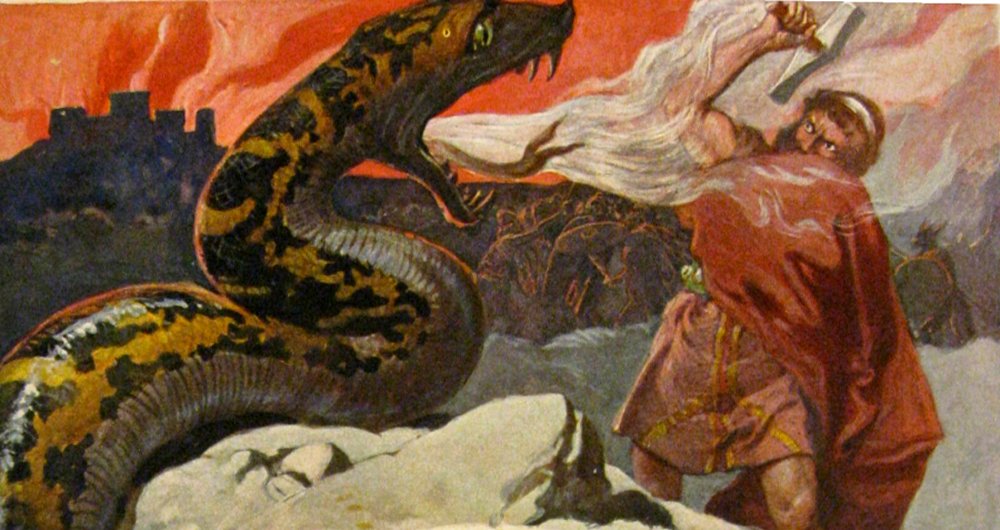A. Sutherland - AncientPages.com - Thor was a very popular deity, particularly in Iceland and the western part of Norway; several complex rituals related to him existed, and when Christianity began to spread in these parts of Europe, it was not easy to eliminate the deep roots of rituals and the cult of Thor.
Photo of the original Thor's hammer in silver found somewhere in Skåne, Sweden, that belonged to a collecton owned by the baron Claes Kurck. Unreliable sources says that the hammer was found in Kabbarp near Staffanstorp in Skåne, Sweden. Photo cropped from the original. SHM 9822:810. Image credit: Ola Myrin, Statens historiska museum/SHM - CC BY 4.0
Thor (called ‘Asa-Thor’ or ‘Ouka Thor’) was a brave and righteous God who mastered storms and lightning, fought giants threatening him, and upheld the world's order.
Thor’s hammer was frequently depicted on boundary stones, carved on gravestones, laid in the bride’s lap at weddings, or raised over a newborn child.
The Viking people possessed silver hammer amulets, miniature hammers designed to be worn as pendants that symbolized their veneration of Thor, the most powerful of the gods and guardian of those who farmed the land.
This protective aspect of Thor is mentioned in Snorri Sturluson’s tales in the ‘Prose Edda’ and in the same way described by the German chronicler Adam of Bremen, who lived and worked during the 11th century.
On the wagon drawn by two goats (Tanngniostr and Tanngrisnir), or just walking, Thor entered Jötunheimr, the home of the fearful giants, armed with his beloved hammer, Mjölnir, iron gloves, a magic belt called ‘Megingiard’ and a mighty magical iron staff Gríðarvölr, so he could kill the giant Geirröd.
He spread destruction and death in Jötunheimr because his most important duty was to protect Asgard against the giants. This formidable weapon could crush everything in its way and, afterward, immediately return to his hand.
Considered invincible, Thor liked to chase giants and demons and kill them with Mjölnir, but this strong and brave god was vulnerable without his hammer, stolen one day by the giants, persistent enemies of the gods.
He had two palaces in Asgard: Thrudheim ("World of strength" in Old Norse) and Bilskirnir (Old Norse "lightning-crack"), the largest building of Asgard with 540 chambers, where he lived with his family. That is the greatest house known to men, according to Snorri’s Edda.
Thor’s widespread popularity has been demonstrated in many ways, especially since his name was popularized abroad by the Vikings, who gave names to their settlements often related to ‘Thor.’
Especially, Iceland has many harbors and headlands with Thor-related names like Thorsness and Thorshofn. In Denmark, there is a town known as Thorsager (Danish for "Thor's Acre" a reference to the Norse god Thor.) Popular, are also Nordic names Thor, Thorgrim, Thorsten. ‘Thursday’ is named after this great god, and Torsdag (in Danish, Norwegian, and Swedish ) is named after god Thor - in English ‘Thursday.
Credit: Adobe Stock - David
Carvings in places as far apart as Altuna in Sweden and Gosforth, England, illustrate Thor’s deeds; legends tell about his encounters with the world’s serpent Midgardsorm. One recounts how Thor went fishing and baited his hook with the head of an ox and managed to catch the serpent on his line.
Written by – A. Sutherland AncientPages.com Staff Writer
Updated on May 19, 2024
Copyright © AncientPages.com All rights reserved. This material may not be published, broadcast, rewritten or redistributed in whole or part without the express written permission of AncientPages.com
Expand for references







